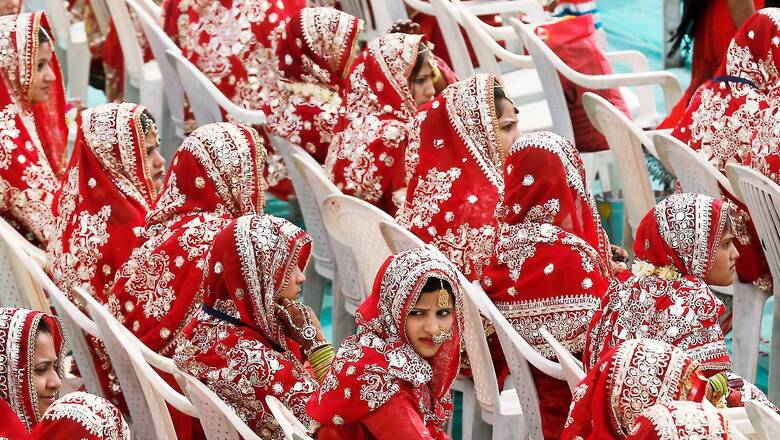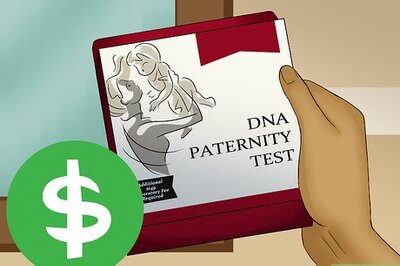
views
Bumble is anecdotal for boredom. When I am on this popular dating app, supposedly meant to be woman-friendly, after months of being inactive — and on the few occasions, I’m inspired enough to right swipe — the first and most common question hurled at me is how come I am not married?
What! Not even, once?
Some of the suitors can’t help but invasively probe.
Middle-class parents? How come they didn’t pressurise you, either?
What! Liberal.
But, but, heck, aren’t you an only child?
Well, at least, you don’t look 44! It was my birthday, the day before.
I humour some of these men and ask them to guess my age. It’s a good ice-breaker. And, I suspect even turns on some of them. I am in my early 30s. Sometimes, and, on a particularly good day, a late 20s.
Probably an auspicious time to add a disclaimer here. This column is not about the datingapades (read debacles/disasters) of a middle-aged, childfree and unmarried Indian woman — never mind that there are officially 74.1 million of us singletons — the highest ever in India’s population or history.
This is me trying to understand the Cabinet’s supposedly progressive and pro-womanly move approving the proposal to raise the legal age of marriage from 18 to 21, bringing it at par with men. Despite a decrease over the last few decades, underage marriages are a grave cause of concern, despite the long-standing prohibition on child marriages.
As many as 23.3% of women aged 20-24 were married before age 18, the legally permissible age of marriage, declares a National Family Health Survey of 2019-21. The problem is more prevalent in rural areas, pegged at 27%, whereas, in urban India, underage marriages accounted for 14.7% of all marriages.
The proposed legislation is aimed at placing women on an equal footing with men and enabling them to pursue career advancement opportunities and higher education. Add to this, the possibility of lowering maternal mortality rates, infant mortality rates and improving nutritional levels, as well as an increase in sex ratio at birth.
But, is it really that simple? That black and white? That matter of fact?
Let’s face it. In India, the centrality of marriage remains the highest validation for womanhood — followed closely by motherhood, and this cuts across socio-economic stratification. A woman’s womb is a precariously ticking time bomb and from the time she is born she is labelled ‘paraya dhan’, (belonging to another); which is why in most communities a woman on her marriage day is officially given away by the patriarch of her clan — as if she is the fiefdom of her family; which is why a woman must marry the man she loves – the social sanctity of her very private/personal/sexual/life choice has to be approved by her entire ‘biradari khandaan’ – blessed sanctimoniously by the community, elders, religious heads and imaginary, distant Gods whose marriages supposedly lasted seven births.
As a woman is paraded, bedecked in shining heirloom jewellery and dazzling lehengas and floor-length gowns and ostentatiously embroidered saris — her head demurely covered. Her eyes diminutively lowered. Her brothers lifting her up or walking alongside her, as she garlands her beau — uttering sweeping vows that peg a woman to the role and performance of a lifetime — never mind if, the statistics I shall now quote all prove that marriage is hardly the supreme form of settlement. In fact, disastrously the opposite.
Dowry-related matters accounted for the lives of 19 women daily, in 2020, the National Crime Records Bureau (NCRB) data in September 2021 has revealed. A total of 6,966 cases of dowry deaths, with 7,045 victims, were reported in 2020, the crime bureau report further added. The number of dowry deaths stood at 7,141 in 2019 and 7,167 in 2018.
Section 375 of the Indian Penal Code defines rape as “non-consensual sexual intercourse with a woman”. However, it exempts the husband from any penal consequences, if he forces intercourse on his wife sans her consent, given that his wife is above the age of 15 years. The 15-year bit was wired down to 18 years by the Supreme Court. Marriage in India under the law means irrevocable implied consent.
Over one third (36.6%) of suicides by women in the world in 2016 were in India, up from 25.3% in 1990, according to a 2018 Lancet report. Married women account for the highest proportion of suicide deaths among women in India because of reasons such as early arranged marriages, young motherhood, low social status, domestic violence and economic dependence, the report said.
According to the Crime In India Report 2018, published by the National Crime Research Bureau (NCRB), a crime is recorded against women in India every 1.7 minutes and a woman is subjected to domestic violence every 4.4 minutes. It also topped the categories of violence against women, according to the report. As per the data, 89,097 cases related to crimes against women were registered across India in 2018, higher than the 86,001 cases registered in 2017.
The National Family Health Survey (NFHS-4), 2015-16 highlighted that 30% of women in India between the ages of 15 and 49 have experienced physical violence. The report suggests that among married women experiencing physical, sexual, or emotional abuse, an alarming 83% list their husbands as the main perpetrators, followed by abuse from their husbands’ mothers (56%), fathers (33%), and siblings (27%).
A single woman — whether she is single by choice or circumstance — sticks out like a sore thumb (39% of the female population, presently). She is categorised as a failure, a guilt trip or as morally deviant — either too ambitious, too promiscuous, too aggressive, too bold/loud/demanding/too materialistic, too much of something or too little, as it were.
Our aloneness is never savoured and celebrated as our strength — a testament to our survival in a male-dominated pecking order where mothers apply “fairness” creams on young, teenage daughters and feed them less than the sons, favoured as powerful descendants to continue the proverbial bloodline and look after aged and ailing parents as a sacred duty; where matrimonial ads specify not just caste and sub-caste, but also our exact body measurements and skin colour and height; where educated and urban women of privilege are paraded to astrologers and voluntarily marry Peepul trees on the lines of actor Aishwarya Rai, before she suffixed Bachchan to her surname, to erase the curse of being Manglik.
Where attrition rates are still staggeringly high at the workplace, as we opt out to be a dutiful, perfect mother or the ‘pativrata’ and ‘sanskaari bahu’. Our fate is to belong. To be owned. To fit in. To remain answerable. To obey. To follow.
And so, in theory, and principle, I like the fact that we can now feel equal to men. But, in a country where gender sensitisation like sex education remains an anomaly, how close are we to actually question female autonomy? How real is this legislation? How fair is it for a government or state, which provides no support structure for single women, except a pension in some sectors to widows to legislate on our behalf and project this as progressive?
Playing an all-powerful ‘Mai Baap’?
So, now a woman can marry at 21. But what if she does not? What if she rejects the institution of marriage, after all? Walks out? Refuses to remarry? Bear a child? Cannot? Who will she piss off? Which God? This time…
The author is the bestselling writer of ‘Sita’s Curse’, India’s first feminist erotica, ‘Cut!’ and ‘Status Single’. A leading columnist on sexuality and genders she is also the founder of Status Single—India’s first and only community for urban single women. The views expressed in this article are those of the author and do not represent the stand of this publication.
Read all the Latest Opinions here




















Comments
0 comment